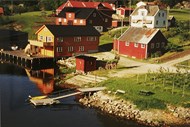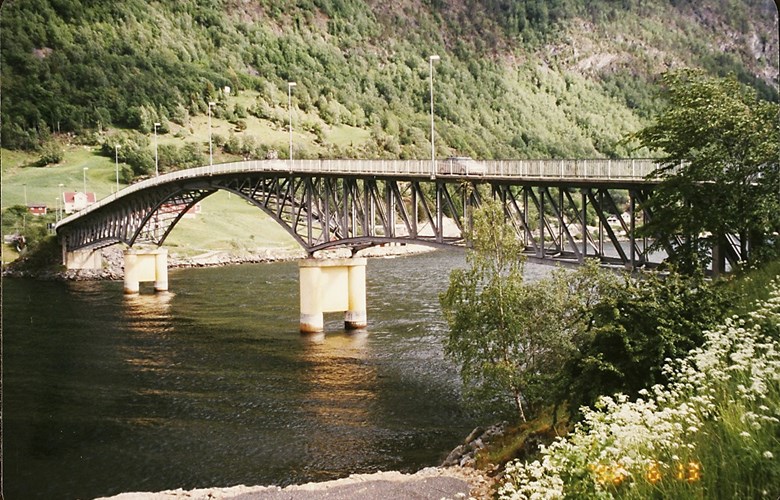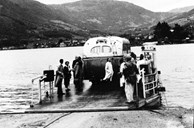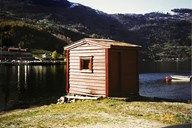The ferryman across the strait
When you drive down to Loftesnes on the eastern side of the Barsnesfjord, you can see an old, weatherbeaten shed at the Loftesnes sawmill. This was the machine house for the cable ferry across the strait before the bridge was built. The short sea crossing between Nes and Loftesnes has been much used throughout the years. It linked the inner Sogn villages on the north side of the fjord to Kaupanger and Lærdal. What year the ferryman was permanently employed remains uncertain, but from the 1880s the job was carried out by Jon Loftesnes. Over a period of fifty to sixty years, he rowed back and forth across the strait. He was accompanied by his daughters Josefine and Sofie when they were old enough to be of any help. Jon frequently used the "big boat" when cattle were transported across, whereas the daughters used the rowboat to take people across. In 1938, a new and improved road was finished between Loftesnes and Loftesnes and Kaupanger, and it then became necessary to get a car ferry. The Public Roads Administration now took over the ferrying business, with Josefine and Sofie in charge of selling tickets onboard.


When the ferry sank
In 1938, the highway authorities used a small shuttle ferry. The ferry was ordered by the chief county road administrator Alf Torp, and it was delivered by "Løland Motorverkstad" at Leirvik. The ferry is said to have been one of the first weldless steel ferries in the country. The ferry was 15 metres (about 50 feet) long with deck space for four private cars. On 9 November, 1941, the ferry sank while being towed back to the shipyard for maintenance and repair. Josefine and Sofie were ready once again to transport people across in a rowboat. Jon was now too old. He had sold the "big boat" to the highway authorities for 300 kroner. Some time later a temporarysolution was found by using a ferry connected to steel wires, operated by a crank mechanism. This operation was far from simple and in wintertime it could even be dangerous when the wire rested on the ice.
New ferry
A new cable ferry was delivered in 1944. The ferry did not only transport people but also sheep, cows and horses. It happened that the animals were frightened and jumped overboard while crossing the fjord, but major accidents were rare. The ferry crossing was not always a pleasant experience in rain and snow as the deck was not covered. The ferry did not run at regular hours either. School children from Barsnes and Loftesnes on their way to school at Trudvang had to get up early in the morning in the hope that cars were about to be transported across. Only towards the end of 1946 were regular departure hours introduced. The fare for one person was the same as for one animal. The ferry service operated until November, 1958. This last year the ferry transported 32 000 cars and 126 000 passengers.
Plans for a bridge across the strait
As early as 1877, plans were made to build a wooden bridge across the strait between Nes and Loftesnes. Only when the Storting (Parliament) allocated money from the so-called compensation budget in 1938, the bridge plans were taken up for reconsideration. A new blueprint was made, but The Second World War put a stop to these plans. The plan to build a new bridge across the strait was resumed only in 1954. On 25 November, 1938, the Loftesnes bridge on national highway no. 565 officially opened for traffic. A crowd of about 1000 persons attended the ceremony. The county governor Nicolai Schei carried out the official opening ceremony by cutting the ribbon strung across the middle of the bridge. The local brass band was the first to cross the bridge on foot, followed by the rest of the crowd. The band returned across the strait to Nestangen on the ferry, and this was the last shuttle the Loftesnes ferry made.

Toll-financed bridge project
The financing of the bridge was meant to come through the state budget, but was in the first instance advanced by means of loan. In order to cover the interest of the loan capital, toll money was introduced. This was the first toll-financed bridge and road project in the county. The municipality of Sogndal was in charge of the construction, and the bridge loan was paid off in the course of six years. In the first year a bus or lorry was charged three kroner, a private car or tractor two kroner, and one kroner for a motor cycle. Bikers and pedestrians did not have to pay anything. Once again it was Josefine and Sofie who took the job to sell tickets. They shared the job between them until the toll-financing came to an end in 1965.






